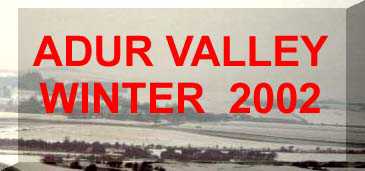WILDLIFE
REPORTS
28
June 2003
Three Peregrine
Falcons were perching near the Shoreham
Harbour Power Station on some of the high dock lamps. These three birds
are thought to be the three chicks born this year and they put up an amusing
display chasing each around the power station chimney (their birth place
in the nest box on the south side) and dislodging each other off the available
perches.
Breeding
Report 2002
In
Widewater
Lagoon, several large Common Eels
have been seen to the east of the bridge. They could only be seen at the
bottom of the lagoon from a very high vantage point on the roof of one
of the houses.
Reports
by Peter Talbot-Elsden (Southwick)
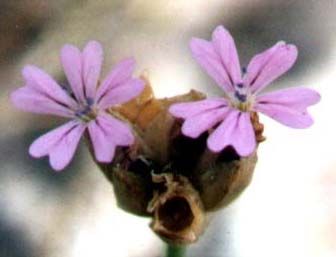
The
Childing
Pink,
Petrorhagia
nanteuilii, is in flower at Silver
Sands (TQ 229 048)
on Shoreham Beach. There are about fifty of these
tiny easily overlooked plants, three or four with the distinctive double
flowers. The first plants must have been flowering for up to a couple of
weeks ago, and they are not yet in their prime. This site is one of just
two remaining sites for this flower in Sussex, although they may have been
planted elsewhere.
 27
June 2003 27
June 2003
Slonk
Hill has been cut in half by the A27 by-pass as the dual carriageway
truck road (constructed 1971) and the southern area of the hill is now
the steep chalky embankments of the dual carriageway.
The
southern bank was adorned like a meadow with an extensive display of Spotted
Orchids, Dactylorhiza
fuchsii, near
the footbridge to Slonk Hill Farm. The
bank attracted butterflies including my first Comma
Butterfly of the year, a Large
White Butterfly with extensive black markings
and a handful of aggressive Meadow Browns
which tended to chase other butterflies away at any opportunity.
There
is a footpath through a Beech and Sycamore copse from the footbridge westwards
and this can be followed for 200 metres. At the western end the embankment
is overgrown with longer grasses and brambles and an occasional Pyramid
Orchid, Anacamptis
pyramidalis.

It
was in this area I discovered my first Ringlet
Butterfly on these Nature Notes pages.
This butterfly persisted in basking with
wings wide open and would not close them for a view of the ringlets.
More
Images
26
June 2003
Amongst
the common House Sparrow
flocks on the waste ground at the eastern end of the Toll
Bridge, Old Shoreham, I spotted a Lesser
Whitethroat*,
the birds clearly distinguished by its white throat. This unpromising looking
ex-railway track supports quite a variety of birds if examined over a long
period, but many are passage migrants and rarely is there a large selection
on just one day. There was a single Painted
Lady Butterfly (brighter
than the recent ones) and a couple of Red
Admirals.
(*
It could just have likely been a Common Whitethroat,
these small birds are usually hiding in a bush.)
 In
the Lancing Ring meadows, the Marbled White
Butterflies were emerging, where 30
Small
Skipper Butterflies readily settled on
the Greater Knapweed. In
the Lancing Ring meadows, the Marbled White
Butterflies were emerging, where 30
Small
Skipper Butterflies readily settled on
the Greater Knapweed.
Full
Report and Pictures from the Lancing Meadows
On
New Monks Farm, Lancing (west of Shoreham Airport) an out of flight season
Peacock
Butterfly, in good condition, settled
south of the Withy Patch.
26
June 2003
I
caught a Twaite Shad, Alosa
fallax, from off the beach at Brighton.

Twaite
Shad (click on the image for a closer look)
"It
was about 48 cm long and like an oversized herring. Its scales were very
large (I kept some as they came off easily on handling).
The
Twaite Shad is a rare endangered migratory fish rarely caught in the English
Channel. It is the commoner of the two shad species found in British waters.
The other species is the Allis Shad, Alosa
alosa.
Both
the Twaite Shad and the Allis Shad are listed on Appendix II of the Bern
Convention and Annexes II and V of the Habitats Directive. They are protected
under Schedule 5 of the Wildlife & Countryside Act 1981.
Further
Information and Later Report
Sussex
Sea Reports
24
June 2003
On
the long grasses, Pyramid
Orchids and Greater
Knapweed north of the upper car park on
Mill
Hill, were
a hundred or more chysalids of the 6-spot
Burnet Moth (pic).
The Marbled White Butterflies (11+)
were
freshly out and looked very bright. There must be females because two males
were competing for the attentions of the female amongst the Cocksfoot and
other grasses.
Full
Report
22
June 2003
6:30
am Prolonged thunder rumbles for over 40 minutes
continuously awoke me from my morning slumber. However, despite this distant
thunder and lightning, and although there was some rain (6.1
mm) in Shoreham, there is no heavy deluge
after the long dry spell.
21
June 2003
-
 The
first female Broad-bodied Chaser is
recorded this year and the first image of the female on the Nature Notes.
There were several of them just below the car park for Summer Down between
Saddlescombe and Devils Dyke. The
first female Broad-bodied Chaser is
recorded this year and the first image of the female on the Nature Notes.
There were several of them just below the car park for Summer Down between
Saddlescombe and Devils Dyke.
-
Shermanbury
(Adur Valley) Wildlife Photographs
19
June 2003
The
field next to the stream (TQ 209 068) to
the west of the Waterworks (Old Shoreham) was like a jungle with thistles
and nettles. Azure Damselflies, Coenagrion
puella, were common (50+) looked
an extremely bright blue at times. Some were black with just a bright
blue tip on their tail and these were Blue-tailed
Damselflies, Ischnura
elegans, but these specimens
avoided the camera.
Images
Adur
Levels
SHRIMPING
FOR FOOD AND FUN
 Local
shrimper Peter Talbot-Elsden, from Southwick, has produced a small booklet
called Shrimping for Food and Fun about catching the brown shrimp
around the coasts of Britain. The shrimps are caught in nets and the book
features the various methods, firstly the push-netting seen over the sand
in shallow water in spring off Southwick, Shoreham and Lancing. The famous
Morecambe Bay shrimps were originally captured by cart shanker shrimping
with a horse and cart in deeper water off the Lancashire coast, later replaced
by a tractor. At Formby, they experimented with amphibious vehicles after
World War II. Nowadays, most commercial shrimping on the east coast around
Kings Lynn trawls from small boats using a net off the stern. Shrimps
are often cooked on board. Local
shrimper Peter Talbot-Elsden, from Southwick, has produced a small booklet
called Shrimping for Food and Fun about catching the brown shrimp
around the coasts of Britain. The shrimps are caught in nets and the book
features the various methods, firstly the push-netting seen over the sand
in shallow water in spring off Southwick, Shoreham and Lancing. The famous
Morecambe Bay shrimps were originally captured by cart shanker shrimping
with a horse and cart in deeper water off the Lancashire coast, later replaced
by a tractor. At Formby, they experimented with amphibious vehicles after
World War II. Nowadays, most commercial shrimping on the east coast around
Kings Lynn trawls from small boats using a net off the stern. Shrimps
are often cooked on board.
The
28 page book contains 40 photographs of shrimping through the ages. It
is available through Bookworms of Shoreham and other local booksellers
at £3.50.
The
booklet is also available through the British
Marine Life Study Society, but at £4 including postage and packing.
Peter
Talbot-Elsden manned the shrimp display at Adur
World Oceans Day.
14
June 2003
A
jellyfish with a bell diameter of 45 cm and one metre long was spotted
in calm seas off Shoreham-by-Sea, Sussex, at 7:00
pm. It was creamy white with a pink-blue rim
so it was almost certainly the Barrel Jellyfish,
Rhizostoma
octopus. These large jellyfish are
only occasionally encountered off the Sussex coast.
BMLSS
Jellyfish page
18
June 2003
Leafcutter
Bees inhabit my Eastbrook Road, south
Portslade, East Sussex, garden. They are probably the species Megachile
centuncularis.
"They
are fascinating to watch. Once the bee has landed on the right leaf it
takes literally seconds for the bee to cut a semi-circle of leaf, rolling
it beneath their legs as they go. Once the piece is free they lift off
slowly and allow themselves to sink down through the bush and exit where
there is a gap in the branches, and laden with its load disappear over
the back wall."
Full
Report
17 June
2003
A
single Oystercatcher
was probing for worms or molluscs
at low tide by the houseboats in Shoreham. This
is unusual during summer.
Adur
Estuary Wildlife
15
June 2003
The
hoverfly
Volucella
bombylans var. plumata was
discovered near the copse on Mill Hill. This
white-tailed hoverfly (pic) is
a bumblebee mimic.
 14
June 2003 14
June 2003
45
Mute
Swans were counted on the still tidal
part of the River Adur at Upper Beeding by the disused
Cement Works. At Beeding
Hill, the Fragrant Orchid
was in flower, and on the road verges above Anchor
Bottom, there were the first observations of Meadow
Brown Butterflies
of 2003. And on Mill
Hill, the Skippers (probably
Large Skippers) put in their first
appearance of the year.
On the lower
slopes the absence of the vast yellow
expanses of Horseshoe Vetch was
my instant impression. The grasses were still the short springy turf and
quickly a Adonis Blue Butterfly
fluttered by. It was one of three seen.
Adur
Butterflies
Bird
of Prey
By
the stile on the border of Mill Hill public
land (area overgrown with scrubbery) and the Old Erringham grazing land
(TQ
207 076), a sleek slate blue-grey raptor flew
in a silent gliding arc on my arrival, and then disappeared. I was looking
down on the bird of prey from above, a rather unusual viewpoint and I noticed
the streamlining of the tail feathers very clearly. My first thoughts were
Sparrowhawk, but this bird seemed to have a different flight pattern and
seemed slightly larger than the male Sparrowhawk. This bird is very likely
to be the rare Hobby, Falco
subbuteo. Estimates of the British summer population of this bird
could be only 500 breeding pairs. The bird can hunt and catch Swallows
and House Martins
and will predate on flying insects. (The area in which it was seen supports
large numbers of hirundines around
Old Erringham Farm as well as butterflies
on Mill Hill and dragonflies and damselflies
on the levels.)
 9
June 2003 9
June 2003
The
Stag Beetles were active at dusk flying
over my south Lancing garden (TQ 186 044).
One
of them was chased by a Blackbird.
The
Beautiful
Damselflies were fluttering around in my Shermanbury
garden.
Shermanbury
(Adur Valley) Wildlife Photographs

5
June 2003
A
Common
Blue Butterfly nectared on Bird's
Foot Trefoil on the lower meadowed slopes
of Lancing Clump.
Photograph
and Report by
Ray
Hamblett (Lancing Nature)
5 June
2003
A
bird hopping about on the grass at Green Court, to east of the southern
"cricket pitch" end of Southwick Green, was light brown colour, with a
distinctive blue and white strip on the wing. It hopped about and did not
fly away.
Report
by Mike Burtt
PS: I
think this can only be a Jay (Andy Horton).
This bird occurs in the Adur district where there are large gardens and
trees.
A Common
Sandpiper was seen at Widewater.
4
June 2003
I
walked from the Mill Hill upper car park along
the lane and down to the stables at Old Erringham, a Little
Owl was in its normal place in the small
copse overlooking the stables but this time sat on a fence post right next
to the road, otherwise just a single Hobby
seen. A few Swifts, Swallows &
House
Martins were around the farm buildings
and a Chiffchaff
also in the copse, plus four Yellowhammers
on Mill Hill.
Small Weever
fish were discovered in the shrimp net (push-net) haul in the sea off Widewater
beach. Weever fish are silvery with a black venomous fin and spines. The
can impart a nasty sting on the unwary and bare foot paddler over the sandy
shallows.
Report
by Russell
Beware
of the Weever page
The
Sea off Sussex
3 June
2003

The
famous Boar Fish, Capros
aper, died after its aquarium sprung
a leak in the middle of the night. (It was caught in November
2002).
2 June
2003
Early
Evening
 The
Horseshoe
Vetch flowers have diminished and the only
blue
butterflies to be seen were Common
Blues amongst the long grasses
on the middle slopes of Mill Hill. The old railway
track at Old Shoreham had already shown a handful of Painted
Lady Butterflies, all faded or dull, and
the numbers steadily increased on the downs until I stopped counting at
50, of which only one was in a pristine colourful condition. A dozen plus
Red
Admirals were also recorded in the scrubbier
areas. A handful of Small Heath Butterflies
were now easily recognised when a few years ago I was not so sure. They
always settled with their wings closed and when open they showed a bright
orange upper wing. It took
Brianne Reeve
to draw my attention to dozens of Common Blue
Butterflies resting wings closed in a small
patch of the long grass north of the car park. If the ones we saw were
extrapolated over the whole area of long grasses there would have been
several hundred. The
Horseshoe
Vetch flowers have diminished and the only
blue
butterflies to be seen were Common
Blues amongst the long grasses
on the middle slopes of Mill Hill. The old railway
track at Old Shoreham had already shown a handful of Painted
Lady Butterflies, all faded or dull, and
the numbers steadily increased on the downs until I stopped counting at
50, of which only one was in a pristine colourful condition. A dozen plus
Red
Admirals were also recorded in the scrubbier
areas. A handful of Small Heath Butterflies
were now easily recognised when a few years ago I was not so sure. They
always settled with their wings closed and when open they showed a bright
orange upper wing. It took
Brianne Reeve
to draw my attention to dozens of Common Blue
Butterflies resting wings closed in a small
patch of the long grass north of the car park. If the ones we saw were
extrapolated over the whole area of long grasses there would have been
several hundred.
The
best spectacle was left to last as a bird with a very bright yellow breast
flew out of the bushes by the reservoir. It looked like an exotic bird
and it must be a male Yellowhammer,
that can look as yellow as a canary during the summer.
Yellowhammer
(Birdguides)
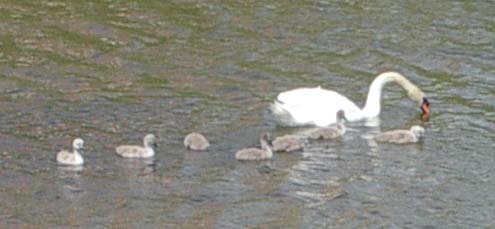 Midday
to Early Afternoon Midday
to Early Afternoon
The
Mute
Swans on Widewater Lagoon have seven cygnets
this year.
Just
a handful of Yellow-horned Poppy
plants are in flower and the Tree Mallow
is now more handsome at the western end of the lagoon.
Red
Admiral Butterflies and faded
Painted
Lady Butterflies, (feeding on Red
Valerian), appeared with a breeze from the
south. I only saw a couple of each in ten minutes, but they looked like
immigrants and later more of both species were seen near Old
Shoreham Toll Bridge.

31 May
2003
Shoreham
bathed in a heat wave up to
24°
C for the opening of the Adur Festival and
Adur
World Oceans Day 2003 on Coronation
Green, Shoreham-by-Sea. About
3000 people attended the event that was steady and busy throughout.
Exhibits
included live fish and lobster in aquaria, colouring and badge-making,
whales
and dolphins, birds, shrimps, fish-tasting, touch-table, Shoreham shingle
beach flora and undersea colour photographs and videos.
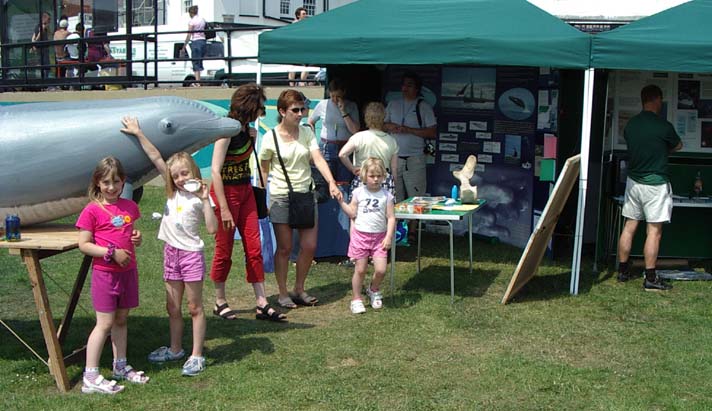
A special
thanks to all the participants, especially Len Nevell (British Marine Life
Study Society) and Steve Trewhella (Marine Conservation Society). The inflated
dolphin was provided by Steve Savage (Sea Watch Foundation).
Several
groups had special exhibitions including the:
British
Marine Life Study Society including Shorewatch
(four exhibits)
West
Sussex County Council Countryside Unit
Sea
Watch Foundation (for Whales & Dolphins)
Sussex
Sea Fisheries District Committee
SeaSearch(Undersea
Biological Recording)
Shoreham
& District Ornithological Society
Sussex
Ornithological Society
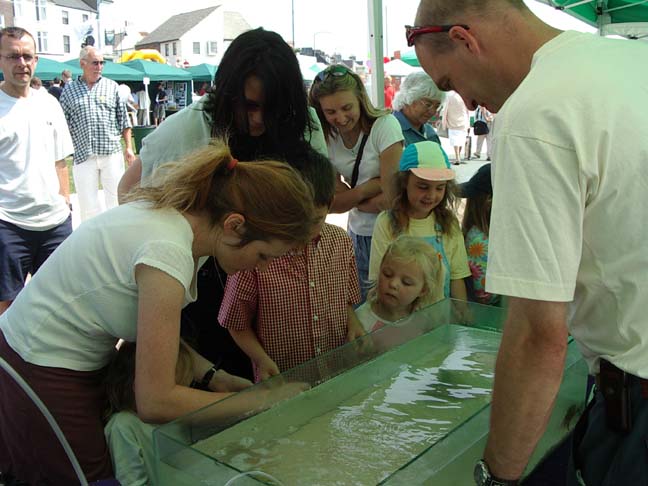
Adur
World
Oceans Day 2003
10:00
am - 4:00 pm
Popular
Information File on Adur World Oceans Day
2003
Acrobat
Information File on Adur World Oceans Day
2003
Adur
World Oceans Day 2003 Images (by Ray Hamblett)
The
Adonis
Blue Butterflies have disappeared from the
lower
slopes of Mill Hill and the vast expanse
of Horseshoe Vetch has
now receded.
Adur
Butterflies
Moths
and Butterflies of Europe and North Africa
30
May 2003
A
half dozen Swifts flew
rapidly to and from over the Hamm Allotments, Shoreham, in the early evening.
The
air temperature reached a sticky 26° C and humid 69% max. Two
Swifts
flew just above house top level over Corbyn Crescent in mid-morning, the
first time I have noticed these fast flying birds over Shoreham town.
There
seems to be a lot of Jackdaws this spring, on the downs (flocks
of a dozen plus) and on houses in the town of Shoreham.
British
Trust for Ornithology web pages
29
May 2003
The
air temperature reached 27°
C, the highest so far this year.
28
May 2003
An
unusual dead lizard was discovered in my Shoreham
beach garden, missing its tail (I fear one of my cats had had it).
It didn't look like either of the two native species - the Common
Lizard or the Sand
Lizard. It was black with very bright green
spots on and about 10 cm without the tail. I'm fairly convinced it
is a Podarcis
muralis (Laurenti, 1768) the Wall Lizard.
NB: Wall
Lizards were released by a herpetologist on
to Shoreham beach several years ago. Most lizards on Shoreham beach are
the Common Lizard, Lacerata viperata.
Old
Fort Lizards
A single
Peregrine
Falcon wheeled around to the next box on the Shoreham Harbour Power
Station chimney and disappeared from view. It appeared very small in the
7 x 50 binoculars.
The
Glaucous
Gull (see below) was
reported from the tidal pool at the western end of Adur Recreation Ground.
27
May 2003
The
Environment
Agency are trying to implement measures
to protect what they believe to be the only remaining Water
Vole population in Sussex on New Monks
Farm, Lancing. The habitat is under threat both from the airport expansion
plans and legal spoil dumping on the 120 acres of unused farmland between
Shoreham Airport and Lancing.
26
May 2003
After
some rainy and dull days, the sun came out again on the Bank Holiday Monday
afternoon.
On the on the lower slopes of Mill
Hill both male
and female Adonis
Blue Butterflies
flew
from one Horseshoe Vetch
flower to another, and occasionally settled on some bare earth patches.
At the top of the ridge a single Common
Blue Butterfly stood out by its clear
bright blue fringed with pure white, in the long grasses south of the reservoir.
It was a small specimen about the size of an Adonis
female.
Full
Report
Morning
A
walk on lower slopes of Mill
Hill this morning through the Horseshoe
Vetch meadow brought sightings of about 30 Adonis
Blue Butterflies with five Cinnabar
Moths and Small
Heath Butterflies with five blue
(possibly Azure) Damselflies as
well.
25
May 2003
A
quick check of the gulls on the Adur opposite
the airfield this evening produced a first summer Glaucous
Gull loafing with about 20 other large
gulls. It was present from at least 6:00 pm,
but flew off south at 6:33 pm.
There were about 200 large gulls roosting near the houseboats later. There
seems to have been an increase of large gulls on Widewater
in the last few days. A passing fishing boat became "engulfed" in gulls
until it was barely visible! (The local boats are currently fishing for
cuttlefish.)
Image
Earlier
Report of the Glaucous Gull
Sussex
Birder Web Site
 A
visit to Woods Mill (Sussex
Wildlife Trust), near Small Dole, enabled close-up views of the
Great
Red Damselfly, Pyrrhosoma
nymphula, and a mating pair
of Azure
Damselflies, Coenagrion
puella. A
visit to Woods Mill (Sussex
Wildlife Trust), near Small Dole, enabled close-up views of the
Great
Red Damselfly, Pyrrhosoma
nymphula, and a mating pair
of Azure
Damselflies, Coenagrion
puella.
Link
to Images
Adur
Damselflies & Dragonflies
24
May 2003
A
Common
Lizard skittered across the towpath the
runs along the eastern boundary with the River Adur estuary.
Adur
Levels
In
Widewater
there were thousands of ovigerous small prawns congregating by the edge
of the lagoon. The prawn species has not yet been positively identified.
23
May 2003
Sheila
Wright and David (Sussex Bat Group) led the
evening walk in the dark up Lancing Ring in
overcast damp conditions, unfavourable for bats as their prey food of insects
were not flying about. On the edge of the woodland the bat detector picked
up the sound of two Pipistrelle
Bats in flight. The bats emit noises from their echo location system,
which cannot be heard by the human ear, but can be picked up and identified
by the bat detector.
These bats were seen flying across the path shortly afterwards. Later a Noctule
Bat was also detected.
UK
Biodiversity Action Plan for the Pipistrelle
Bat
Conservation Trust: Bat Information
Full
Report
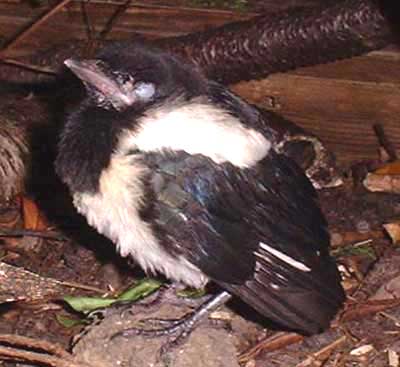 22
May 2003 22
May 2003
In
order to sustain themselves and their offspring, the local Magpies
my south Lancing garden, (TQ 186 044), have
set upon the Sparrows
for diet supplements. I witnessed a Magpie
disembowelling an unfortunate Sparrow.
Yesterday one of the adults was tearing pieces from an unidentified small
bird.
21
May 2003
A hatchling
Magpie has fallen or been pushed out of
the nest in the Hawthorn Tree at the bottom of my south Lancing garden.
(TQ 186 044). It cannot fly and is hiding
from marauding cats in the undergrowth.
A Glaucous
Gull (1st or 2nd summer), Larus hyperboreas, is
seen again at Widewater, Lancing at 10.15
am and again at 11.30
am, when it flew towards the River
Adur. The Glaucous Gull is
an Arctic species and a rare visitor to southern England. It is a large
species only exceeded in size by the Great
Black-backed Gull, one of which has been
resident at Widewater since the beginning of 2003.
Image
17
May 2003
My
first large fungi (mushroom-like) of the year are seen in short
grass at the edge of heavy scrub next to the Waterworks Road (south end),
Old Shoreham (TQ 207 066).
The fungus is photographed below. The cap diameter was about 20 mm, but
I forgot to examine the gills and stem. Emile
Vandecasteele has identified this as probably Coprinus
plicatilis via the Fungi
British Isles Yahoo Group. This species
is very common and can found on garden lawns.
Cercle
mycophile du Condroz (web pages with photographs)
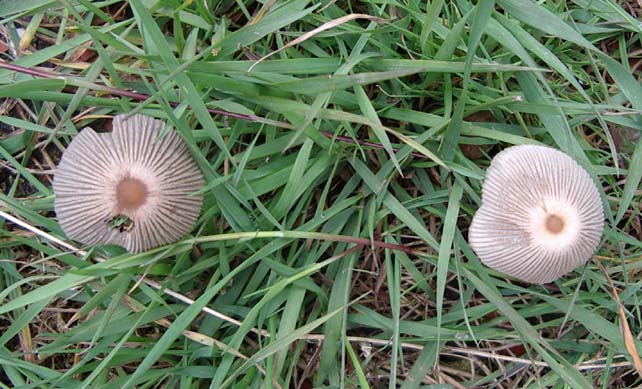
17 May
2003
Around
8:00
pm this evening I noted two dead
adult Mute Swans
mid river on the sand bank opposite the Ricardo factory near Shoreham Airport
(just north of the Toll Bridge).
The
Living Churchyard
Wildlife
Walk
St.
Mary de Haura Church, Shoreham-by-Sea 10:30
am
Wildlife
in the churchyard with Brianne Reeve (Birds) and Betty Bishop (Flora) Steve
Davey (Lichens) and Peter Hodges (Insects). The wildlife tour was organised
by Marion Standing.
On
an overcast day the rain held off for a wildlife survey of the churchyard,
with its collection of park trees and common ground flora of grasses, medicks,
dandelions, buttercups
etc.

|
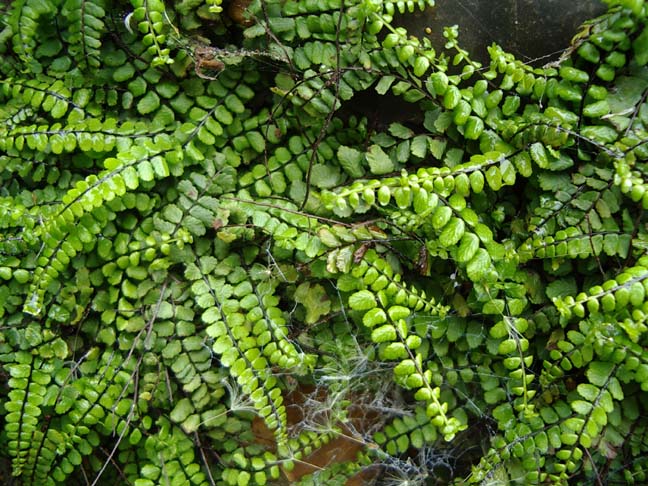
|
|
Pellitory
of the Wall
|
Spleenwort
|
The
Pellitory
of the Wall, Parietaria diffusa, and the Spleenwort,
Asplenium,
grew in the cracks in the church stonework. Both these plants and inhabitants
of old walls and they are rarely found elsewhere.
Shoreham
Herald Report
14
May 2003
A
couple of Wheatears
on Lancing Beach Green were the first I had seen this spring. The soil
and gravel that had been disturbed for the pipeline at Widewater
was like a bare desert between large drifts of the Sea
Thrift. A pair of Ringed
Plovers rose from amongst the Thrift.
Images
of Disturbed Land (Link)
12
May 2003
Salinity
in Widewater Lagoon is recorded at a high level
of 30. Seawater in the English Channel is about 34.
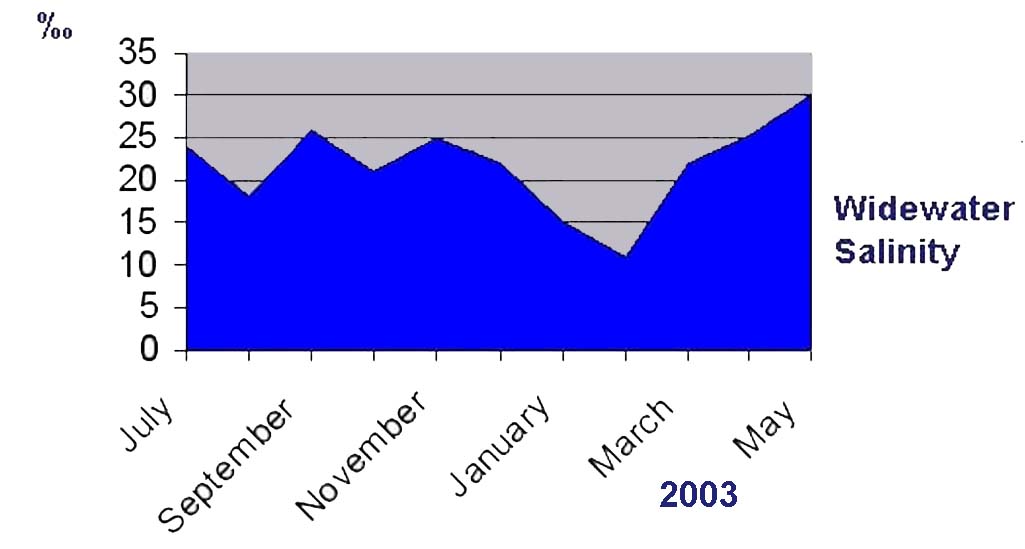
This
is the highest recorded salinity in the last year. Is fresh seawater being
allowed through the pipeline into the lagoon to maintain a high level?
Widewater
Salinity Records 2002-3
11
May 2003
Brianne
Reeve (Shoreham & District Ornithological Society) led the walk on
Lancing
Ring and meadows on behalf of the Friends
of Lancing Ring. We were greeted by a
screaming pair of Swifts,
but otherwise it was more of an audio show, the birds calling from the
bushes. An exception was a Yellowhammer
on the top of a Gorse bush.
Full
Report
 10
May 2003 10
May 2003
A
nest of caterpillars of the Common Lackey
Moth, Malacosoma
neustria, appeared on my 'John Downie'
Crab Apple tree in my
south
Lancing garden.
(TQ 186 044). About 200 or so caterpillars
are protected by a spun blanket of silk. After emerging the caterpillars
have climbed en-mass to high branches where they commenced feeding on the
leaves.
9
May 2003
The
Gorse-lined
bridleway from north Southwick (Hawkins Close) to Southwick
Hill and Thundersbarrow recorded just three Wall
Brown Butterflies and nothing else worth
mentioning, unless you count a dozen Jackdaws
on the National Trust grazed grassland.
So
uninteresting that I retraced my steps and took the path down to Mossy
Bottom. My attention was drawn to a pair of birds calling stridently to
all and sundry from a barbed wire fence by a Hawthorn tree at the junction
with the path down to Slonk Hill (TQ 225 078).
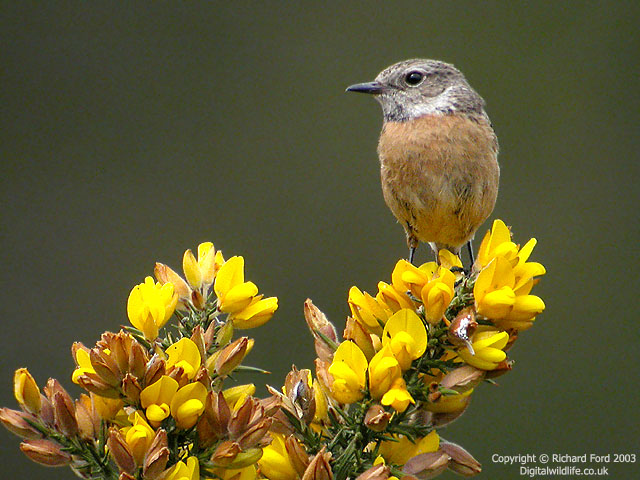
Female
Stonechat
Photograph
by Richard Ford (not taken on the Sussex downs)
(click
on the image for the Digital Gallery of British wildlife photographs)
The
male
Stonechat was particularly striking with
its almost black cap, really quite a red breast and just a glimpse of white
on the throat. The male frequently cocked its tail in an upright manner.
The female Stonechat
was
a rather pale brown comparatively, perched only about two metres away on
the same wire.
At
Mossy Bottom I do not know if it was a Sparrowhawk
or a Cuckoo which flew rapidly to the small
copse in the south-west. The hovering Kestrel
at New Erringham was unmistakable.
On
the Mill Hill lower slopes (Vetch
Trail) the following butterflies were
spotted in order of conspicuity:
 Adonis
Blue 50+ (mostly males observed) Adonis
Blue 50+ (mostly males observed)
Brimstone
x 2
Peacock
x 2
Small
Copper 4+
(my first record from Mill Hill)
Small
Heath 6+
Dingy
Skipper 12+
Grizzled
Skipper 3+
Speckled
Wood one (in the scrub)
There
was just one Cinnabar Moth spotted
amongst other day-flying moths, in the expanse of
Horseshoe Vetch and other plants in flower
including a few Cowslips
and Milkwort
(mostly blue, some were purple: I am not sure which species?). All the
plant species are indicative of a classic chalkhill meadow.
Full
Report
Blue
Butterflies (Photographs 2002-3)
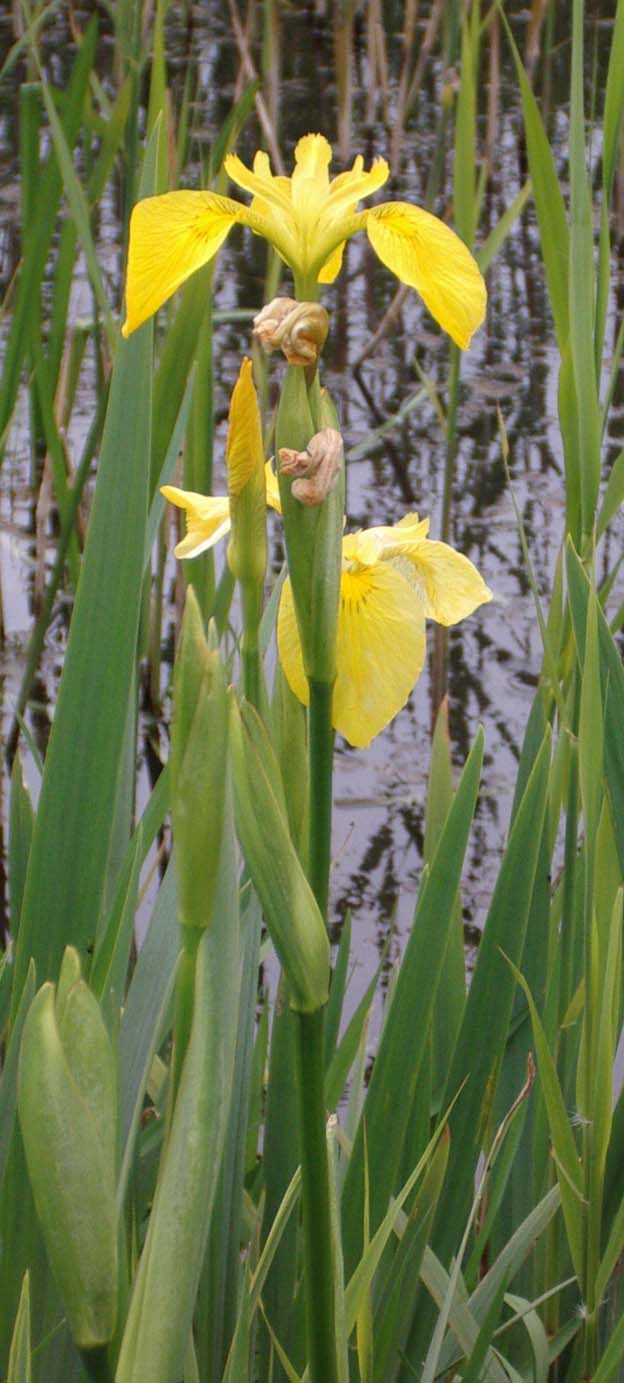 8
May 2003 8
May 2003
On
the Adur Levels (TQ
209 068) to the west of the Waterworks (Old
Shoreham) no damselflies or dragonflies
appeared. There was little movement at all, the inevitable Moorhens
in the reeds, a Blackbird
and Meadow Pipit
showed, and a handful of Wood Pigeons
were disturbed. In the sheep field to the north, I spotted the white rump
of a large Roe Deer as
it disappeared in the eastern demarcation bushes from the Mill
Hill lower meadows.
7 May
2003
A
couple (not a pairing?) of extraordinary
small birds (larger than a Willow
Tit, smaller than a Chaffinch)
flew over the Railway Viaduct over the
River Adur, Shoreham in the direction of Adur Recreation Ground and Shoreham
Airport. These birds were redder in the
breast than Chaffinches
as well, with a stripe in their tail feathers.
Their
funny behaviour was the way they tried to hide in the grass on the east
bank, but the grass was too short and after shuffling down for a bit, they
flew off. This 'hiding in the grass behaviour' is not known to me for Chaffinches
and I do not know it for any bird as I have never seen anything like this
before.
The
overwhelming consensus on UK
Birdnet and the Sussex
Birds Yahoo Group, as well as other local
reports, is that these birds are Linnets
and
I
agree.
Linnets
are common on the downs in summer.
Terrain
(click on this text for an image)
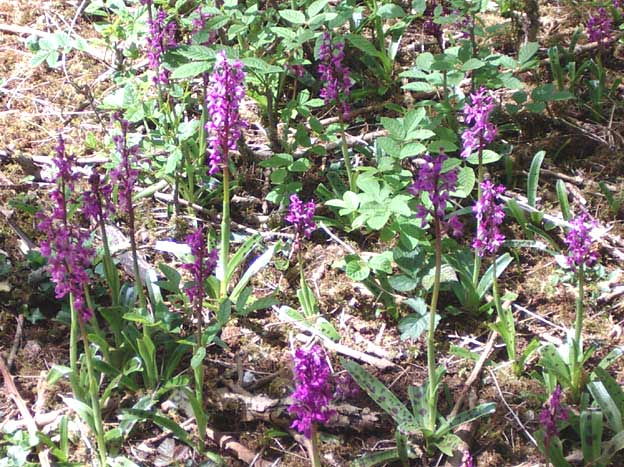
The
Early
Purple Orchids, Orchis
mascula, made a fine show under the
canopy of Lancing Clump. There
were scarcely any butterflies
in the meadows though, just a handful of
Small Tortoiseshells and Speckled Browns
where
it was shady.
A north
facing meadow, next to the bridlepath from the road to Lancing College
(just north of the Sussex Pad road) to Hoe Cottages (on the route west
to Lancing Clump), was covered in flowering Cowslips
(pic).
6
May 2003
Afternoon
The
Holly
Blue Butterflies laid their eggs in the
Holly flowers in my
south
Lancing garden.
(TQ 186 044).
As
the River Adur turns on the approach from the sea north of the A27
Flyover, the unmistakable downturned long beaks identified either a
couple of Whimbrels
or a pair of Curlews
that
seemed to be resting or feeding in the lee of the west bank at mid-tide.
This was the first time I had seen these waders on the river estuary
and they came as a bit of a surprise. Alas I did not have experience to
differentiate the two species. It seemed that the shorter more downturned
beak was nearer the Whimbrel,
but I failed to observe the differences in the head markings between the
two species of wading birds with downturned beaks. (However,
the beak of the male Curlew is shorter than that of the female. Whimbrels
have been identified from the Arun valley this month, but both species
could be passage migrants.)
 At
Cuckoo's
Corner, the flash of orange and white
of the male
Orange Tip Butterfly
was sudden and unmistakable. There were a couple of the larger all-white
females as well. From the trees on the Lancing College side of the
road, a Cuckoo
called just once. At
Cuckoo's
Corner, the flash of orange and white
of the male
Orange Tip Butterfly
was sudden and unmistakable. There were a couple of the larger all-white
females as well. From the trees on the Lancing College side of the
road, a Cuckoo
called just once.
The
drainage ditch running north from Cuckoo's Corner was choked with floating
weeds or algae. Scores of Small Tortoiseshell
Butterflies, mostly faded, fluttered over
the grasses and plants by the stream's edge.
On
the Widewater flood plain,
on the gravel and soil that had been lifted to install the new
pipeline and then replaced, the Sea
Campion was noticeably in flower.
Morning
A
pair of Speckled Wood Butterflies
flirted on the Waterworks Road with a handful of Red
Admirals on the footpath skirting the
horse's field on the way up to Mill Hill. On
the lower Horseshoe Vetch
covered slopes visited yesterday, a few Small
White Butterflies were conspicuous but
it was the other butterflies that proved to be of interest. There were
many more blue butterflies
around, at least 30 seen, some flirting and others chasing different species
off the Horseshoe Vetch
flowers. I still have these down as Adonis
Blue Butterflies. All seemed to have the definitive black marks in
the white fringe of the upper wing.
Blue
Butterflies Identification page
Conservative
numbers of the other butterflies actually
seen on the lower slopes were as follows:
 Grizzled
Skipper 25+ Grizzled
Skipper 25+
Dingy
Skipper 15+
Small
Heath 15+
Brimstone
one
Orange
Tip one (my first record
from Mill Hill)
Wall
Brown
4+ (on the paths between the scrub near
the Triangle)
Adur
Butterflies
Vetch
Trail Images
5 May
2003
I
followed the Vetch Trail on
the lower slopes of Mill
Hill towards Old Erringham on a sunny May Bank Holiday Monday. Several
acres of the steep slopes were graced by the yellow flowers of the Horseshoe
Vetch (the food plant of the Adonis Blue
and Chalkhill Blue
and other butterflies.)

The
vivid blue colouring of just the one Adonis
Blue Butterfly was startling as it chased
away a Small Heath Butterfly
from the flower of a Horseshoe Vetch. The
underside wing of the Adonis
was heavily pigmented with brown. The Small
Heaths settled with their wings closed,
but it seemed that were about to open them, but they never did. The Painted
Lady was a battered specimen with parts
of its wing missing.

|

|
 |
|
Adonis
Blue
|
Grizzled
Skipper
|
Cinnabar
Moth
|
The
Dingy
Skippers with at least 25 scattered over
a wide area were the commonest butterflies in flight, but I saw a handful
of Grizzled Skippers
and the red of the single Cinnabar Moth
was most striking when it fluttered around just above the rabbit-cropped
plants.
There
were a few Speckled Wood Butterflies and
there was one Red Admiral
that followed me in the dense scrub incline, or several of them.
Adur
Butterflies
Vetch
Trail Images
Day
Flying Moths List
Trees
and undergrowth have been removed to the west of Shoreham-by-Sea railway
station at the south of Raven's Road, Shoreham. There are still all the
larger trees left. This is a good town area for birds.
Railtrack
Policy
4 May
2003
A
Large
Red Damselfly,
Pyrrhosoma
nymphula, visited
my south Lancing garden pond. (TQ
186 044). On 9
May 2003 two males were seen in Norton Tea
garden in Henfield, Sussex (TQ 213 161).

Adur
Dragonflies
3
May 2003
A
dead
Common
Frog was discovered in my Lancing garden
pond (TQ 186 044) with
all the symptoms of the Red Leg Disease.
The
disease is now understood to be caused by a virus, probably an iridovirus
belonging to the genus Ranavirus.
The disease was known from Surrey in the 1970s.
Image
Red
Leg Disease Fact Sheet

29 April
2003
A Green
Hairstreak Butterfly was a notable observation near Pepperscombe (near
where the South Downs Way passes west of Steyning). (TQ
160 110)
A
Brimstone
Butterfly fluttering along the railway
embankment near the Eastern Avenue railway crossing in Shoreham came as
a bit of a surprise as I had not seen one for over a decade in this area.
However, this was nothing compared to the shock of seeing a Yellow
Wagtail almost out of my front window
on the roof of my house, in Corbyn Crescent (TQ
224 053), opposite. At least, I thought it
was an immigrant bird, not a Grey
Wagtail, which has been recorded before
in Shoreham town. The tail seemed relatively short.
The bird flew suddenly from the roof to the ground and then disappeared
and I could not rediscover it with my binoculars. This first hand sighting
confirmed a report from a week earlier. Corbyn Crescent is poor for bird
variety.
25
April 2003
I
was serenaded by a Common
Whitethroat singing in the Silver Birch
in my Shadwells Road, Lancing garden. It then spent 30 minutes or so in
the shrubs before flying off to the north. Shadwells Road is near the 200
acres of open space known as New Monks Farm.
Now
I have at last seen a falcon fly off the Shoreham Harbour Power Station,
not from the chimney but from the main part of the tall building. I would
not have penned it as a Peregrine
and
I did not have my binoculars. With my relatively inexperienced eye, I would
have put it down as a Sparrowhawk and
it appeared much smaller than I expected. The swoop and glide was distinctive
and this was identical to the bird of prey I saw nine days ago near Mossy
Bottom. On reflection, its preference for an open area was unlike that
of a Sparrowhawk.
A
Tern
(bird species not discerned) was flying eastwards as the sea rolled in
on Southwick beach.
22
April 2003
A
Jay,
followed by a Jackdaw,
flew into the trees on the other (east) side of the road from the dovecote
on the Dovecote Estate, Downsway, Shoreham. It was a sunny day, but the
downs
were surprisingly devoid of butterflies,
although a Speckled Wood Butterfly
was seen in the copse on Mill Hill.
More
Images of Mill Hill
Several
Dingy
Skipper Butterflies were seen on Mill
Hill.
 20
April 2003 20
April 2003
A
Dingy
Skipper Butterfly was seen by the side
of the Industrial Estate at Golding Barn near Upper Beeding (near Steyning)
in the Adur valley on a breezy overcast Easter Sunday morning. This species
is not often recorded, although it it is known from Mill
Hill.
A Nightingale
was heard over Cokeham
Reed Beds, west Lancing. (TQ 167 043).
A single
Orange
Tip Butterfly and just one Speckled
Wood Butterfly was seen at Woods Mill
(Sussex WWT, nr.
Small Dole).
18
April 2003
Lancing
Clump in the sunshine produced the following five species of butterflies:
 Speckled
Wood x 6 Speckled
Wood x 6
Small
Tortoiseshell x 4
Comma
x 1
White
sp. x 3
Peacock
x 4
Butterflies
of Lancing
On
the edge of grassland I caught sight of a Magpie
trying to steal a Field Vole from
the edge of a run into the scrubby hedge.
Lancing
Ring Nature Reserve
Map
of Lancing Ring
Lancing
Ring 2003
I
saw my first Orange Tip Butterfly
of the year below Henfield
in the Adur valley. Also a Comma Butterfly,
among the normal Small Tortoiseshells
and Peacock Butterflies.
Upper
Adur East (Shermanbury area) Nature Pages
17
April 2003
Lancing
Beach
It
was a very low spring tide and a visit to the shore
not to be missed by rockpoolers. However, although
most of the common crabs were present, there nothing
of special note to be seen in the shallow pools and under rocks.

The
green blobs are the egg case of a worm
Phyllodoce
maculata
Link
to a Special Report
The
red
body and humming-bird flight of a burnet-style moth
in Shoreham town (New Road, eastern end) was rather unusual at this time
of year and it is being investigated.  The
best suggestion is that it could have been a Cinnabar
Moth, Tyria jacobaeae, and the
caterpillars of these moths are common on Ragwort, which is abundant locally
in wayside spaces and unkept fields (unofficial countryside). This moth
usually appears in May at the earliest. The
best suggestion is that it could have been a Cinnabar
Moth, Tyria jacobaeae, and the
caterpillars of these moths are common on Ragwort, which is abundant locally
in wayside spaces and unkept fields (unofficial countryside). This moth
usually appears in May at the earliest.
16
April 2003
From
the bare field to the south-west of Southwick Hill
the melody of a Skylark filled
the air for ten minutes or more without a break. It
would need a directional microphone to record the songs because in the
distance the hum of the traffic on the A27 could be heard as well as clattering
from the dockside at Shoreham Harbour over two miles to the south.
The
small falcons are not always to separate at a distance, but the blunt-shaped
head and swooping flight, landing on a fence post, together with the subdued
colours (compared to a Kestrel)
indicated a male Sparrowhawk
at New Erringham Farm in the dip of the downs north of Shoreham.
The
shirt sleeves sunny weather was unseasonal (warmest April day since 1988),
recorded at 22° C in
the shade and this brought the butterflies out with 50+
Small
Tortoiseshell Butterflies from the bridlepath
by Slonk Hill Farm
northwards past New Erringham to Mill Hill,
with 15+ Peacock Butterflies and
to my surprise five Brimstone Butterflies
on
and around Mill Hill.
 15
April 2003 15
April 2003
On
a pleasantly warm (18.5° C)
calm day, a handful of Small White Butterflies
were
seen in Sompting, together with my first Holly
Blue of the year. However, the 20+
Small
Tortoiseshell Butterflies were the commonest
on the wing in near the fields. On the levels (New Monks Farm) and paths
up to
Lancing Clump, Peacock
Butterflies numbered at least 30, some
in pristine condition, one battered with torn
wings.
Wild
plants in flower on Lancing Ring included Wood
Anemones, Lesser Celandine and Daffodils.
Adur
Butterflies
Four
immigrating Wheatears
have arrived by Widewater Lagoon.
15
April 2003
A
couple of Speckled Wood Butterflies
were spotted behind Steyning in the Adur valley.
Upper
Adur East (Shermanbury area) Nature Pages
13
April 2003
On
the cyclepath just north of Old Shoreham,
I spotted a
Brimstone Butterfly (first record on these
pages from this area) and four Skylarks
over the water meadows.
11
April 2003
Just
a single Small White Butterfly
in Eastern Avenue, Shoreham. The annual population explosion of these butterflies
has not occurred yet.
8 April
2003
In
the chilly east wind, the signs of spring on the trees bring a brightness
in the weak sun. On the beach between the
pebbles, the wild plants push forth new shoots.
Shingle
Flowers of Shoreham Beach
The
new pipeline from the sea to Widewater Lagoon
has been landscaped and now merges into the shingle bank. After
a couple of months of low rainfall, the lagoon salinity rises to a high
figure of 25.5 (as high as any recording last year).
Widewater
Salinity Records 2002-3
7 April
2003
A
Pheasant
poked his long head above the grass to the call in the fields next to the
cycle
path north of Old Shoreham. It did not fly away but crouched down so
it was almost invisible.
5 April
2003
At
midday we saw a large
bird of prey flying east towards Lancing
College. The bird was flying towards us at a height of about 100 metres.
The immediate impression was of a powerful, bulky bird of prey, in size
close to a female Peregrine.
The bird had a relatively slow wing beat and was mainly gliding. It also
appeared to preen once whilst gliding. In shape the bird resembled an over-grown
Sparrowhawk.
The
sun was high and it was not possible to see a great amount of plumage detail
as we watched the bird for roughly 20 seconds. Through our binoculars the
immediate impression was of an exceptionally light coloured bird. The only
markings that were apparent were a very prominent thick black bar at the
base of the underside of the tail, and a prominent black line running along
the front edge of the wings from just behind the carpal join to the outer
primary. The only other marking appeared to be a slight darkening towards
the front of the birds belly. We could not make out any more plumage detail
than that, and specifically we could not see any markings on the head,
or further barring on the birds body, wings or tail. The bird was not wearing
jesses which would indicate a falconer's escape.
Full
Report
Honey
Buzzards 2000
The
first couple of Holly Blue Butterflies
as well as an Orange Tip
near the petanque court at Lancing Manor, and a single Small
Tortoiseshell Butterfly and one Brimstone
are seen in sunny Lancing.
Butterflies
of Lancing
4 April
2003
A
pair of flirtatious Peacock Butterflies
fluttered over my Lancing garden (TQ
186 044) on this very warm April day.
1
April 2003
A
Magpie
dived
headlong into the perched Collared Dove,
removing a beak full of feathers as it dislodged its target from the tree
at the bottom of my south Lancing garden (TQ
186 044).
In
the garden pond, the clumps of Frog
spawn has now all developed into a mass of wriggly
tadpoles, the vast majority of which are
active in the still gelatinous clump. A small number have begun to stray
to other areas of the pond.
|


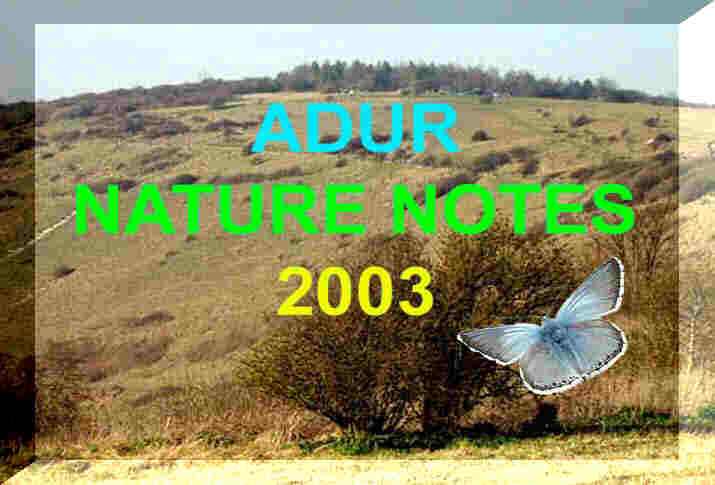

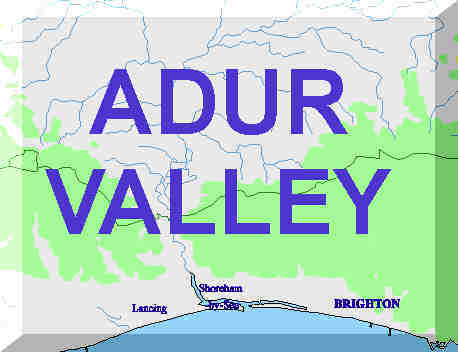

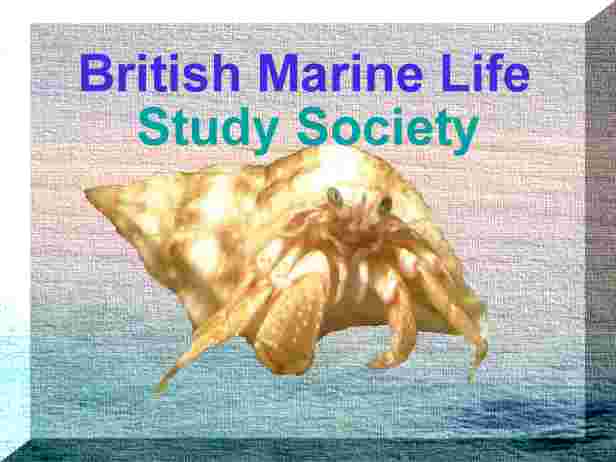
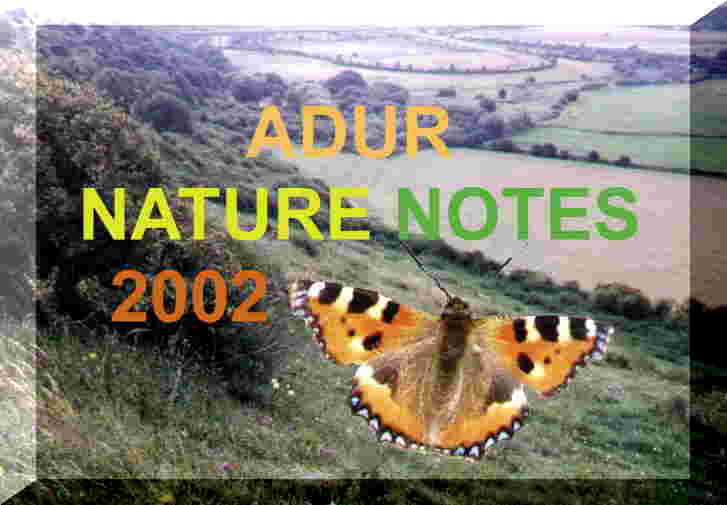



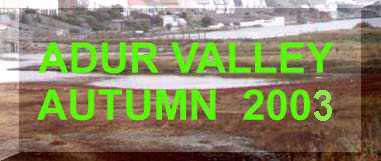



















 8
May 2003
8
May 2003














